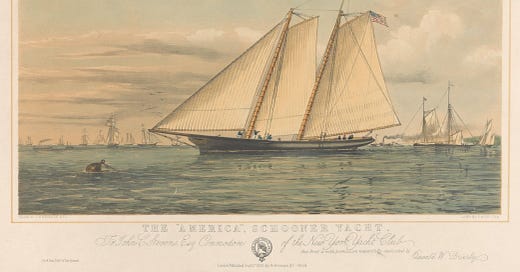At about this time in 1851, the New York Yacht Club’s schooner, America, races and defeats fifteen yachts of the Royal Yacht Squadron. Did the Americans forget that they were supposed to lose?!? The New York club was then still relatively new, whereas the British one was older and more prestigious.
Yet again, Americans began as the underdog—and emerged victorious!
That 1851 race laid the foundation for the international racing competition today known as the America’s Cup. In modern times, hundreds of millions of dollars are spent by those striving to win, but that first race in 1851 set the stage for everything that was to follow.
Naturally, it all started with men, on both sides of the Atlantic, motivated to build fast ships.
The New York Yacht Club was established in 1844, and it began working with East Coast boatbuilder William Brown to create a craft “faster than any vessel in the United States brought to compete with her.” These Americans wanted to compete, and they wanted to bring home prize money.
In the meantime, the older Royal Yacht Squadron had gained a new Commodore. The Earl of Wilton was looking for ways to promote his club. In May 1851, it was decided to create a £100 Cup for a race around the Isle of Wight. The British hoped to attract international competitors, particularly Americans, to their race.
Thus, the schooner America set out across the Atlantic in June 1851 prepared to compete, yet it didn’t go to Britian right away. Instead, the ship traveled to France, where the schooner could be refitted and prepared to race before the British spotted their competition.
John C. Stevens, an owner of America, later spoke to a New York crowd, describing the moments when his schooner finally arrived in England:
“The yachts and vessels in the harbor, the wharves, and windows of all the houses bordering on them,” he said, “were filled with spectators, watching with eager eyes . . . . I have seen and been engaged in many exciting trials at sea . . . without feeling one-hundredth part of the trepidation I felt at the thought of being beaten by the [British] Laverock.”
Cannons fired at 10 a.m. on August 22, signaling the start of the race, but America got off to a poor start. “[F]or the first few hours of the most famous race in yachting’s history,” the America’s Cup website explains, “it was a game of catch-up.”
America gained the lead just as she was beginning her trip around the back of the Isle. The task was harder than it sounds, as George L. Schuyler of the New York Yacht Club later described. The British decision to race there, he noted, “is notoriously one of the most unfair to strangers that can be selected . . . the currents and tides render local knowledge of more value than swift sailing and nautical skill.”
America’s crew maintained their lead, despite the difficulty. In the end, America would finish nearly 20 minutes ahead of her nearest competitor.
As America sailed towards the finish line, she reportedly passed a yacht bearing Queen Victoria. “Which is first?” she asked. “The America,” a response came. “Which is second?” “Ah, Your Majesty, there is no second.”
Did the exchange actually occur? Uncertain, but “its succinct line has stuck with the America’s Cup since and beautifully encapsulates the competition,” the America’s Cup website concludes.
The international racing competition known as the America’s Cup was soon formally established, with the trophy named in honor of its first winner. Would you believe the New York Yacht Club retained the title of champion for more than 100 years before another country won?
Naturally, that is a story for another day.
Sources can always be found on my website, here.





I have always tried to keep track of the races but they do not garner the attention they once did. Thanks for the memory of this great race!
Wow. I did not know any of this story. Thank you Tara. I, of course, knew of the America's cup but now, I understand why it is so prestigious.